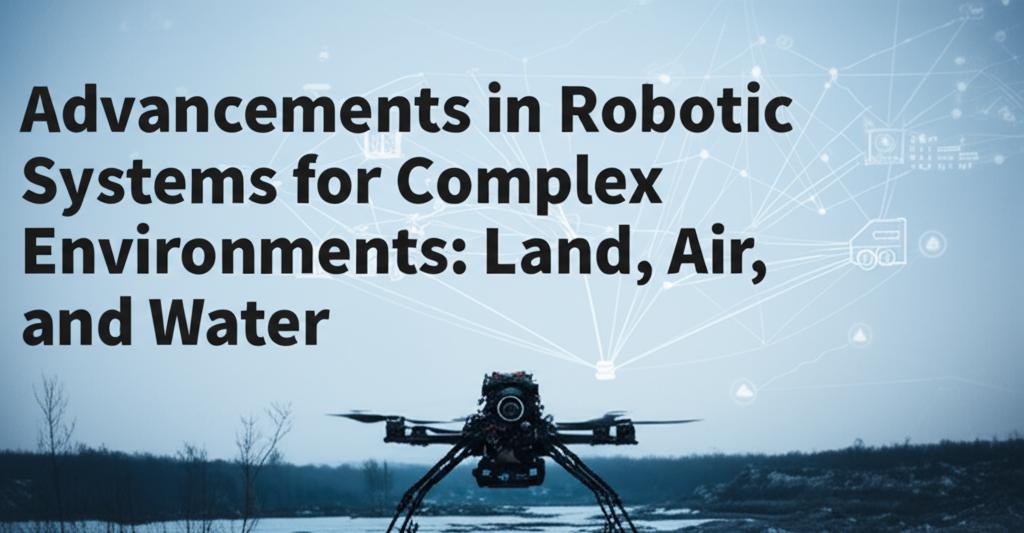Robotic systems are increasingly venturing into complex and hazardous environments, pushing the boundaries of what's possible in exploration, inspection, and intervention. Recent advancements highlight significant progress in robotic capabilities across land, air, and water domains, often leveraging the power of Artificial Intelligence (AI) and sophisticated sensor technologies.
Key Advancements and Trends:- Enhanced Autonomy and Navigation: AI is a driving force in modern robotics, significantly improving how robots perceive, navigate, and interact with their surroundings.
AI-Powered Perception: Robots utilize AI models to process data from sensors like cameras, LiDAR, and sonar, enabling them to understand complex scenes, recognize objects, and identify obstacles. Deep learning, particularly Convolutional Neural Networks (CNNs), has revolutionized robotic vision.
Simultaneous Localization and Mapping (SLAM): SLAM technologies are fundamental to autonomous navigation, allowing robots to build maps of unknown environments while simultaneously tracking their own position. Recent advancements in SLAM combine LiDAR and vision systems to overcome individual sensor limitations and improve accuracy, especially in dynamic or poorly lit conditions. Visual SLAM (vSLAM) incorporates AI to interpret visual data, identify objects, and even understand semantic meaning within an environment.
Adaptive Path Planning: AI algorithms, including reinforcement learning, enable robots to learn from experience and adapt their navigation strategies in real-time to dynamic conditions, unexpected obstacles, and changing terrains. This allows for more efficient and safer operation in unpredictable settings. Researchers are developing algorithms that help robots balance travel time with the probability of success in uncertain environments, finding shortcuts while ensuring safe passage.
- Cross-Domain Robotics: There's a growing focus on developing robots capable of operating in multiple domains – land, air, and water.
Amphibious Robots: Innovations include amphibious robotic dogs that mimic mammalian swimming styles for efficient transitions between land and water. Other designs focus on enabling robots to not only travel on land and in air but also to perch on vertical surfaces, drawing inspiration from gecko behavior for applications like disaster rescue and reconnaissance.
Multi-Modal Systems: Research explores how different types of robots (e.g., Unmanned Aerial Vehicles (UAVs), Autonomous Ground Vehicles (AGVs), and Autonomous Surface Vehicles (ASVs)) can collaborate and share information to achieve complex mission goals. Challenges include ensuring effective communication and coordination between diverse robotic platforms.
- Robotics for Extreme Environments: Robots are increasingly deployed in places too dangerous or inaccessible for humans.
Robust Design: Engineers are developing robots with enhanced resilience to withstand harsh conditions like extreme temperatures, high pressures, radiation, and contact with hazardous materials. This includes innovations in mobility (e.g., tracked vs. wheeled vs. legged locomotion for different terrains) and self-healing or radiation-hardened systems.
Specialized Applications: Examples include robots for nuclear decommissioning, offshore energy infrastructure inspection and maintenance, deep-sea exploration, space exploration (including navigating the Moon or Mars), and disaster response in collapsed buildings or lava fields.
- Human-Robot Interaction and Collaboration: Advancements are being made in how humans control and interact with robotic systems, especially in complex scenarios.
Collaborative Robots (Cobots): These robots are designed to work safely alongside humans, often featuring intuitive interfaces and enhanced safety features.
Teleoperation and Shared Autonomy: Improved human-robot interfaces, including augmented reality (AR) and virtual reality (VR), allow for more intuitive remote operation. There's also a focus on systems that can safely switch between different levels of autonomy, allowing human intervention when needed.
Swarm Robotics: In disaster response, for instance, swarms of smaller, coordinated robots can navigate hazardous areas, gather information, and support rescue operations. Efforts are underway to enable a single human operator to control and coordinate multiple robotic systems across different domains.
- Improved Sensors and End Effectors: The ability of robots to perceive and interact with their environment is heavily dependent on their sensors and manipulators.
Advanced Sensing: Innovations in sensor technology provide robots with richer and more accurate data about their surroundings. This includes enhanced vision systems, tactile feedback, and environmental awareness.
Manipulation: For tasks requiring physical interaction, advancements focus on creating robotic arms and end-effectors (grippers) that can handle a variety of objects, including those that are soft, fragile, slippery, or unusually shaped.
Future Outlook:The field of robotics is poised for continued rapid advancement. By 2025 and beyond, expect to see:
- Hyper-Intelligent Robots: AI will enable robots to solve more complex problems, process natural language more effectively, and even demonstrate forms of creative thinking.
- Increased Autonomous Mobility: Robots will become even better at navigating complex and dynamic environments independently.
- Soft Robotics: Progress in soft robotics will lead to manipulators capable of delicate tasks, expanding applications in areas like handling fragile items in electronics or food processing, and in healthcare.
- Bio-Inspired Designs: Robots inspired by animal locomotion and behavior will continue to offer solutions for navigating challenging terrains and performing complex actions.
These advancements are revolutionizing industries from manufacturing and logistics to healthcare, agriculture, environmental monitoring, and space exploration, paving the way for robots to take on increasingly complex and critical tasks in a variety of challenging environments.

